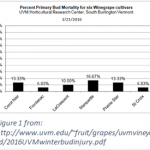Tim:
Feel free to forward this to other NGP affiliates. Even though it refers to ‘Vermont and surrounding areas’, I am not against others filling it out so long as they enter their state so that I can sort the data.
Thanks, Terry
By: Terence Bradshaw
The University of Vermont Grape Program is conducting a survey of cold-climate grape producers to assess cultivar, training system, and yield patterns in Vermont and surrounding states’ vineyards. Producers from Vermont, other New England states, and northern New York are invited to participate. Results from the survey will inform important activities in support of grape and wine producers in the region. For example, we recently submitted a letter of intent to the Vermont Specialty Crops Block Grants Program to conduct research on issues relevant to our maturing industry, including evaluation of promising new cultivars and adaptation of pruning and training systems that address needs of mature vineyards. Another recently-funded project through the Northeast IPM Center submitted by Team member Dr. Ann Hazelrigg will develop a Pest Management Strategic Plan for cold-climate grapes. This thorough survey of vineyards in the region will provide important data that will guide these and other projects. In addition, data from the survey, including prices received by growers for cold-climate cultivars, may be used to develop realistic revenue estimates for use in crop insurance programs.
The survey may be found at: https://survey.uvm.edu/index.php/229889/lang-en.
It will not take long to take the survey, but it would be helpful to have records on planting date, cultivar, training system, and yield available when you complete it. The survey has been approved by the UVM Institutional Research Board and all data is collected anonymously and no information identifiable to specific vineyards will be collected or published in any resulting reports. The survey will be open until April 15.
Thank you for your participation and feel free to distribute the link to other growers in the region.











